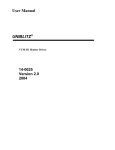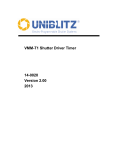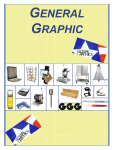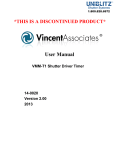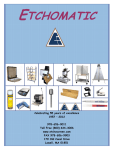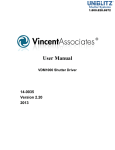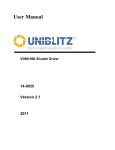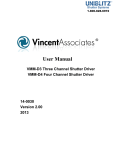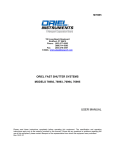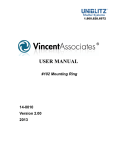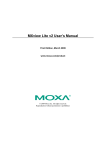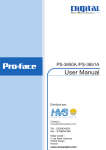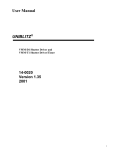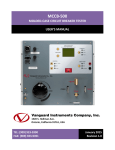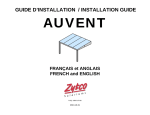Download User Manual - Vincent Associates
Transcript
1.800.828.6972 User Manual VCM-D1 Shutter Driver 14-0025 Version 3.20 2013 VCM-D1 User Manual For information regarding applicable intellectual property, please visit www.uniblitz.com/patents. Information in this publication supersedes that in all previously published material. Due to our ongoing development program, Vincent Associates reserves the right to discontinue or change specifications or designs, at any time, without incurring any obligation. Version 3.20 2013 Vincent Associates, a Division of VA, Inc., 803 Linden Ave., Rochester, NY 14625 Tel: 585-385-5930 Fax: 585-385-6004 UNIBLITZ is a registered trademark of VA, Inc. Printed in the U.S.A. VCM-D1 User Manual 1 WARRANTY LIMITED PRODUCT WARRANTY: All Products manufactured by VINCENT ASSOCIATES® (MANUFACTURER) are warranted to meet published specifications and to be free of defects in materials and workmanship as defined in the specifications for 365 days - one year - (WARRANTY PERIOD) from the date of original shipment of the product. DSS series shutters are additionally warranted to achieve two million cycles within the WARRANTY PERIOD (as defined in the CYCLE WARRANTY CRITERION). MANUFACTURER will, at its own option within the WARRANTY PERIOD, repair or replace without charge any listed item discovered to be defective excepting transportation charges. Burned out or otherwise damaged actuator coils are not covered under this warranty. Any defective product returned to the MANUFACTURER must follow the RETURN MATERIAL AUTHORIZATION PROCEDURE as defined below. This warranty does not extend to cover damage resulting from alteration, misuse, negligence, abuse, normal wear and tear, or accident. The MANUFACTURER will consider the return of unused equipment if returned within 30 days from the original date of shipment, subject to a 20% restocking charge. This offer does not apply to used or damaged equipment. This warranty extends only to the original purchase and is not available to any third party, including any purchaser assemblies or other Products of which the goods may become component equipment. CYCLE WARRANTY CRITERION: One "cycle" is considered one open and one closure of the shutter. DSS Shutter must be operated with the ED12DSS driver or equivalent HBridge type shutter driver circuit at +10.7VDC across the actuator coil for the specified duration. DSS Shutter must be operated within the defined environmental, electrical and mechanical specifications as listed on the device's data sheet. After one year (WARRANTY PERIOD), the cycle warranty is null and void. If returned, the device must be accompanied by a written statement indicating the approximate number of cycles contained on the device, include all parameters to which the shutter was operated and follow the RETURN MATERIAL AUTHORIZATION PROCEDURE as defined below. RETURN MATERIAL AUTHORIZATION (RMA) PROCEDURE: MANUFACTURER will only accept returned Products from customers that have obtained an RMA (Return Material Authorization) number from the MANUFACTURER. The customer must also include an itemized statement of defect(s). The Product will then be evaluated per the MANUFACTURER'S standard repair guidelines. Any Product which has been returned to the MANUFACTURER but which is found to meet the applicable specifications and not defective in materials and workmanship shall be subject to the MANUFACTURER's standard evaluation charge. The MANUFACTURER assumes no liability for customer returned material. LIMIT OF LIABILITY: The buyer's exclusive remedy and the limit of MANUFACTURER'S liability for any loss whatsoever shall not exceed the purchase price paid by the buyer for the goods to which a claim is made. MANUFACTURER does not give any implied warranties of merchantability, fitness for a particular purpose, or of any other nature in connection with the sale of any Products. VCM-D1 User Manual 2 Table of Contents WARRANTY .................................................................................................................................. 2 LIST OF FIGURES ....................................................................................................................... 4 LIST OF TABLES ......................................................................................................................... 4 GENERAL SAFETY SUMMARY ............................................................................................... 5 Injury Precautions .......................................................................................................................... 5 Product Damage Precautions ........................................................................................................ 6 Safety Terms and Symbols .............................................................................................................. 7 PREFACE ....................................................................................................................................... 8 GETTING STARTED ................................................................................................................. 10 Features ........................................................................................................................................ 10 Introduction .................................................................................................................................. 11 Start Up ........................................................................................................................................ 12 Line Fuse Replacement................................................................................................................. 14 Voltage Change ............................................................................................................................ 15 Shutter Fuse Replacement ............................................................................................................ 16 Initial Operation and Testing ....................................................................................................... 17 OPERATOR CONTROLS .......................................................................................................... 19 VCM-D1 Front Panel Operator Controls .................................................................................... 19 VCM-D1 Rear Panel Operator Controls...................................................................................... 24 OPERATING BASICS ................................................................................................................ 29 Function Switches......................................................................................................................... 29 Gate Input ..................................................................................................................................... 31 Mode Selection ............................................................................................................................. 33 RS-232C Operation ...................................................................................................................... 35 Daisy-Chain Configuration .......................................................................................................... 36 RS-232C Test Program................................................................................................................. 37 Shutter Frequency of Operation ................................................................................................... 41 Trigger Cautions and Trouble Shooting Tips ............................................................................... 41 Pulse Voltage Graphs ................................................................................................................... 42 Dimensions ................................................................................................................................... 45 Maintenance ................................................................................................................................. 46 General Care ................................................................................................................................ 46 Inspection and Cleaning ............................................................................................................... 46 Inspection – Exterior .................................................................................................... 46 Cleaning Procedure – Exterior ..................................................................................... 46 Inspection – Interior ..................................................................................................... 47 Cleaning Procedure – Interior ...................................................................................... 47 SPECIFICATIONS ...................................................................................................................... 48 System Characteristics ................................................................................................................. 48 External Input Characteristics ..................................................................................................... 49 External Output Characteristics................................................................................................... 52 General Characteristics ............................................................................................................... 54 Applicable Certifications .............................................................................................................. 57 INDEX .......................................................................................................................................... 58 VCM-D1 User Manual 3 List of Figures Figure 1: AC Input Module .............................................................................................................. 15 Figure 2: VCM-D1 Front Panel Operator Controls ...................................................................... 22 Figure 3: VCM-D1 Rear Panel Operator Controls....................................................................... 28 Figure 4A and 4B: Gate Input Timing Diagram ........................................................................... 33 Figure 5: VCM-D1 Daisy-Chain Cable Configuration ................................................................ 37 Figure 6: Pulse Voltage vs. Exposure Time ................................................................................... 42 Figure 7: Pulse Voltage vs. Frequency ........................................................................................... 44 Figure 8: Overall VCM-D1 Dimensions ......................................................................................... 45 List of Tables Table 1: 5-Pin SwitchCraft Pin-Out ............................................................................................... 26 Table 2: General Pin-Outs for 25-Pin D-Sub and MAC 8-Pin Mini-DIN ................................... 35 VCM-D1 User Manual 4 General Safety Summary Review the following safety precautions to avoid injury and prevent damage to this product or any products connected to it. To avoid potential hazards, use the product only as specified. Only qualified personnel should perform service procedures. Injury Precautions Use proper Power Cord – To avoid fire hazard and risk of personal injury use only the power cord supplied with this product. Avoid Electric Overload – To avoid electrical shock or fire hazard do not apply a voltage to a terminal that is outside the range specified for that terminal. Avoid Electric Shock – To avoid injury or loss of life, do not connect or disconnect line cord while it is connected to the line voltage. Ground the Product – This product is grounded through the grounding conductor of the power cord. To avoid electrical shock, the grounding connector must be connected to earth ground. Before making connections to the input or output terminals of the product, ensure that the product is properly grounded. DO NOT DEFEAT THE GROUND CONNECTION ON THE SUPPLIED LINE CORD. Access to On/Off Switch – Due to the location of the unit’s On/Off switch on the rear panel, do not position the unit such that the On/Off switch is difficult to access and operate while installed and in use. Do Not Operate Without Covers – To avoid electric shock or fire hazard, do not operate this product with case or covers removed. Use Proper Fuse – To avoid fire hazard, use only the fuse type and rating specified for this product. Do Not operate in Wet/Damp Conditions – To avoid electric shock, do not operate this product in wet or damp conditions. Do Not Operate in an Explosive Atmosphere – To avoid injury or fire hazard, do not operate this product in an explosive atmosphere. VCM-D1 User Manual 5 Product Damage Precautions Use Proper Power Source – Do not operate this product from a power source that applies more than the voltage specified. Provide Proper Ventilation – To prevent product overheating, provide proper ventilation. Do Not Operate with Suspected Failures – If you suspect there is damage to this product, have it inspected by qualified service personnel. VCM-D1 User Manual 6 Safety Terms and Symbols These terms appear in this manual WARNING Warning statements identify conditions or practices that could result in injury or loss of life. CAUTION Caution statements identify conditions or practices that could result in damage to this product or other property. These symbols appear on the equipment ATTENTION – Refer to user manual. VCM-D1 User Manual 7 Avertissements de sécurité Ces termes et illustrations apparaissent dans le manuel AVERTISSEMENT Le titre AVERTISSEMENT indique une situation où, si l’avertissement est ignoré, de graves blessures ou la mort peuvent en resulter. PRUDENCE Le titre PRUDENCE indique une situation où, si l’on ne fait pas attention, cela risqué d’entraîner des dommages à l’équipement ou à d’autres propriétés. Ces symboles sont présents sur l’équipement ATTENTION – Se référer au manuel d'utilisation. VCM-D1 User Manual 8 Preface This Manual provides information for the VCM-D1 Shutter Driver. The manual contains the following chapters: Getting Started contains a brief product description, information needed to power on the drivers, fuse replacement and voltage change information, and a brief procedure to verify that it functions. Operator Controls provide an outline of the panel control functions and locations at the front and rear panels. This also includes the location and function of the input/output signals. Operating Basics give further details to the operational features of the controllers. Specifications are described for all input/output levels as well as timing accuracy of the VCM-D1 Shutter Driver including other pertinent details and information required for the RS-232C interface. Index contains a full index. Following is the complete operator’s manual for the UNIBLITZ® VCM-D1 Shutter Driver. Please read this manual completely before operating your unit. Due to the construction of this unit, we recommend that the unit be returned to the manufacturer for repair, no user-serviceable parts inside. VCM-D1 User Manual 9 Getting Started Features The UNIBLITZ VCM-D1 replaces the VMM-D1 controller for those customers requiring CE/UL/CSA certification. The VCM-D1 contains all of the features of the VMM-D1. Some new features have been added to enhance the unit’s capability in even more demanding applications. These new features include: RoHS Compliant UL/CSA certification and CE compliance. An addressable RS-232C input through an RJ45 input connector. Eight VCM-D1 units can be daisy-chained together by connecting the RJ45 output to the RJ45 input of the next controller within the chain. The user can select an address for each unit in the chain at the rear panel. Switching capability on all input and output BNC connectors to provide either an activehigh or an active-low logic trigger level. An AUX (auxiliary) output that can be toggled high to low and low to high by RS-232C commands. A GATE INPUT which will allow the user to select single or multiple trigger signals from a stream of trigger signals. A LOCAL/REMOTE switch which will effectively disconnect all input signals from the controller allowing the user to manually control the shutter without the need to remove the signals from the BNC inputs or the front panel terminal strip. RS-232C signals are also disabled in the LOCAL position. A manually re-configurable AC input module for either 115 VAC or 230 VAC operation. This AC input module includes the AC power cord input receptacle, power switch, dual line fuses, line voltage change over fuse block, and line filter. A switch to disable the Electronic Synchronization System of a shutter so-equipped. A new SwitchCraft™ locking type shutter output connector. Enhanced CONTROL terminal at the front panel which now also includes the +5 VDC and AUX outputs. These were previously located at the rear panel with the VMM-D1. All voltage outputs are internally fuse protected – not user-serviceable. VCM-D1 User Manual 10 Introduction The UNIBLITZ VCM-D1 is capable of controlling all traditional shutter types in the UNIBLITZ product line. It incorporates a state of the art shutter driver while relying on the input signal to determine exposure and frequency. The VCM-D1 also permits the selection of an interrupt mode. This mode selection makes the VCM-D1 more versatile for applications where the shutter must not re-open until acted upon by the user. With the MODE switch in the “A” position the unit will disable itself upon an AC line loss. When power is restored, the unit will remain disabled until reset. In the “B” position the unit will become disabled when a DC voltage level is removed from the interrupt input. When the input is restored, the unit will remain disabled until reset. The STD mode will bypass the interrupt capability. The GATE INPUT is used in conjunction with TRIGGER INPUT. This allows the user to pick one or a finite number of trigger pulses to trigger the controller from a continuous stream of pulses presented at the TRIGGER INPUT. The VCM-D1 contains an addressable RS-232C input along with an RS-232C output. By connecting the RJ45 OUTPUT of one controller to the RJ45 INPUT connector of the next controller in the daisy-chain using the optional 810RJ cable, up to eight units can be individually controlled from one computer serial port. The VCM-D1 patented driver design allows the controller to operate all traditional shutter types in the UNIBLITZ product line. A model number 710A, 3 meter, 7-pin Wire-Pro™ female to 5-pin SwitchCraft™ male locking shutter interconnect cable is also included with each unit. The VCM-D1 has successfully completed and is certified to CE/UL/CSA Safety and EMC certifications. Please refer to the APPLICABLE CERTIFICATIONS section elsewhere in this manual. VCM-D1 User Manual 11 Start Up After unpacking your unit inspect for any obvious defects and that all manufacturer supplied materials are present. If a problem is found or a part (or parts) is missing, please contact Vincent Associates immediately for problem resolution. Do not attempt to connect the unit if defects or damage are noted until Vincent Associates has been contacted and the problem resolved. CAUTION Be sure the proper line cord is used. PRUDENCE Assurez-vous d'utiliser le cordon d'alimentation approprié. Line cords are included with the VCM-D1 for both Domestic (USA) and Overseas (EU) line connection. If the included EU line cord is not compatible, use a line cord rated for 230VAC, minimum 1 Amp, and 0.75 mm2 minimum conductor size. Maximum cord length is 3 meters. After the initial inspection, the unit is ready to use. To properly install and power on the VCM-D1, perform this procedure: 1. Check for proper electrical connections. Please note the label covering the AC input module, it is there as a reminder to manually configure the AC input module if the unit requires operation at 230 VAC. See Voltage Change instructions elsewhere in this manual. CAUTION PRUDENCE This label must be removed prior to inserting the power cord into the AC input connector regardless of which AC voltage level is used. Caution statements identify conditions or practices that could result in damage to this product or other property. Cette étiquette doit être enlevée avant d'insérer le cordon d'alimentation dans le connecteur d'entrée AC, quel que soit le niveau de tension AC utilisé. 2. Check the line fuses to be sure they are the proper rating. The VCM-D1 is shipped with the proper fuses for 115 VAC operation (two 3AG, 0.5A time-lag). For 230 VAC operation, change the two line fuses to two 3AG, 0.25A time-lag (supplied). See Line Fuse Replacement instructions elsewhere in this manual. VCM-D1 User Manual 12 3. Be sure the AC module power switch is selected to the “0” position and the line cord is not connected to the AC line. 4. Connect the supplied line cord to the rear panel AC module receptacle. Be sure the cord is inserted completely into the AC module receptacle. 5. Connect the line cord to the AC line. 6. Please Note: The VCM-D1 power switch is located on the rear of the case. Please be sure that it is readily accessible at all times when in use. 7. Power ON the unit by rocking the AC module power switch to the “1” position. Power LED indicator will illuminate. VCM-D1 User Manual 13 Line Fuse Replacement WARNING AVERTISSEMENT To avoid injury or death, unplug the line cord from the line voltage power source before continuing. Pour éviter les risques de blessures ou de mort, débranchez le cordon d'alimentation de la source de tension avant de débuter cette précédure. 1. A small flat-bladed screwdriver or similar tool is needed to complete this procedure. Please refer to Figure 1. 2. BE SURE THE LINE CORD IS DISCONNECTED FROM THE LINE VOLTAGE POWER SOURCE. DO NOT CONTINUE WITH THIS PROCEDURE WITHOUT REMOVING THE LINE CORD FROM THE VCM-D1. 3. Unplug the line cord from the AC module receptacle. Do not proceed without removing the line cord from the VCM-D1. 4. Position the VCM-D1 unit so that the rear panel is facing you. 5. Using the small flat-bladed screwdriver or similar tool, insert the tool into the cover door slot, gently pry open cover door. 6. Insert the tool into the fuse holder slot and gently pry out the fuse holder block. 7. Remove defective fuse(s); replace with new fuse(s). 8. Replace fuse holder into housing 9. Close the cover door. VCM-D1 User Manual 14 Figure 1: AC Input Module Voltage Change WARNING AVERTISSEMENT To avoid injury or death, unplug the line cord from the line voltage power source before continuing. Pour éviter les risques de blessures ou mort, débranchez le cordon d'alimentation de la source de tension avant de débuter cette précédure. 1. Please refer to Figure 1. 2. Repeat steps 1 ─ 6 in Line Fuse Replacement instructions. 3. To change from 115 VAC to 230 VAC, rotate the fuse holder block 180. 4. Replace the two 3AG, 0.5A time-lag fuses with two 3AG, 0.25A time-lag fuses. (Note: Be sure to change fuses back to 3AG, 0.5A time-lag fuses when changing back to 115VAC). 5. Replace fuse holder block and close the cover door. The desired line voltage will be indicated in the cover door window. VCM-D1 User Manual 15 Shutter Fuse Replacement 1. Please refer to Figures 2 for the VCM-D1 front panel layout. 2. A medium flat-bladed screwdriver or similar tool is needed to complete this procedure. 3. Power the unit OFF and disconnect the line cord from the line voltage power source. 4. Position the VCM-D1 unit such that the front panel is facing you. If necessary, disconnect the shutter cable from its 5-pin SHUTTER connector on the rear panel. 5. Using the screwdriver, or similar, insert the tool into the slot on the SHUTTER FUSE cap. Apply slight inward pressure and rotate the cap 1/8 turn, counterclockwise. The fuse cap will pop out slightly. 6. Remove the fuse cap and fuse. 7. Replace the fuse with a known good one. The shutter fuse is a 0.6 A, 5 x 20 mm, time-lag (slo-blo) type. 8. Reverse the procedure to re-install the fuse cap, reconnect all cables and power the unit back up. VCM-D1 User Manual 16 Initial Operation and Testing WARNING AVERTISSEMENT Be sure power switch is in the off position before connecting the power cord to line. Attach line cord to the unit first before plugging into the AC power source. Veuillez vous assurer que le commutateur d'alimentation est en position OFF (éteinte) avant de brancher le cordon d'alimentation. Branchez d'abord le cordon d'alimentation à l'appareil avant de le raccorder à la source de tension 1. The VCM-D1 is manually selectable to operate from 115 VAC or 230 VAC (50-60Hz). PLEASE BE SURE THAT THE UNIT IS PROPERLY SET UP FOR THE LINE VOLTAGE TO BE USED. Refer to the Voltage Change section of this manual for further information and procedures. 2. Once the line cord has been attached to unit and connected to a properly grounded wall receptacle, the unit may be energized. See Start Up section. 3. Insert the 5-pin male connector of shutter interconnect cable into 5-pin female receptacle at rear of unit labeled SHUTTER. 4. Connect the 7-pin female connector of shutter-interconnect cable to 7-pin male connector on shutter to be driven. 5. Place POWER switch to the ON “1” position, the POWER LED will illuminate. 6. Place the N.O./N.C. switch into the N.O. position. The shutter will open and remain open until the switch is returned to the N.C. position. The green DRIVER LED will illuminate when this switch is in the N.O. position. 7. All UNIBLITZ drivers provide the circuitry necessary to support shutters equipped with the solid state synchronization option. Simply plug the shutter-interconnect cable into the driver. If the shutter is equipped with this option the green LED labeled SYNC will illuminate when the shutter is in the open position. In addition, the SYNC output BNC will change to the active state when the shutter is open. The absence of the solid state synchronization option will inhibit the operation of the SYNC output and SYNC LED. The remainder of the VCM-D1 systems will not be affected. 8. See SPECIFICATIONS and OPERATOR CONTROLS for additional operational information concerning other features of the VCM-D1. 9. Should the shutter and/or controller not respond as described previously, be sure line cord is installed into the receptacle and connections to the shutter are made properly. Note that the shutter output is also fused, located at the front panel (0.6 A, 5 x 20 mm VCM-D1 User Manual 17 time-lag). Check these fuses for failure. Please see the Shutter Fuse Replacement section elsewhere in this manual. 10. Be advised, a visual inspection of a fuse is usually NOT an adequate test to determine if a fuse failure has occurred. Use a DMM (Digital Multi-Meter) or equivalent test device to determine fuse continuity. CAUTION PRUDENCE Turn off the unit and remove the plug from the AC source before checking for blown fuses. Éteignez l'appareil et débranchez le cordon d'alimentation de la source de tension AC avant de vérifier si les fusibles sont brulés. 11. Additionally, please note that particular shutter units respond to different minimum pulse widths. For example, a standard VS25 shutter has a minimum exposure pulse of 6 ms. If the timing is set for an exposure pulse width less than 6 ms the shutter may not open fully. 12. If the unit still does not operate properly, turn off and disconnect the unit. Please notify Vincent Associates immediately. There are no user-serviceable parts outside or inside of the unit. VCM-D1 User Manual 18 Operator Controls VCM-D1 Front Panel Operator Controls Please refer to Figure 2. 1. CONTROL Terminal block. The seven-position terminal block referred to on the driver (and throughout this manual) as CONTROL provides access to several of the input and output connections for external operation of your driver. Each terminal is explained below: a. CONTROL #1 Output: +10.0 VDC provided for remote switching applications or control circuits. b. CONTROL #2 Pulse In: Active-high input to control shutter exposure for duration of positive pulse or electronic or mechanical switch contact closure. Shutter will follow pulse and frequency applied to this input. This will operate the same as when the PULSE INPUT BNC is set to the active-high mode. c. CONTROL #3 GND: This ground point allows user to connect input or output signals to ground (common) the VCM-D1 circuit. d. CONTROL #4 Input: DC interrupt voltage. With key switch set to mode B, the interrupt will be activated when input DC voltage (+8VDC min.) is disrupted via a switch, transistor, or similar method. Note: This input is for DC voltage only. e. CONTROL #5 Output: When an interrupt is activated this normally-low output is high until a RESET deactivates the interrupt. f. CONTROL #6 AUX Output: The VCM-D1 AUX output is an active-low pulse output that can be toggled TTL-high and TTL-low from commands to the RS-232C control input. See AUX Out (CONTROL pin 6) under EXTERNAL OUTPUT CHARACTERISTICS. g. CONTROL #7 Output: +5.0 V is provided for remote switching applications or control circuits. 2. MODE Key switch: The position of the key switch sets the interrupt mode. It disables the shutter driver when a voltage interrupt is detected, either AC or DC. Upon reset, the shutter will return to the position set by an external input or the position of the N.O./N.C. toggle switch. a. STD: The STD mode bypasses the driver's interrupt capabilities. CONTROL #4 and CONTROL #5 become inactive. The VCM-D1 will not remain disabled after a disruption in line voltage. b. A (AC interrupt mode): Prevents the driver from re-opening the shutter immediately upon power-up if the line voltage were to be interrupted. The driver remains disabled until user supplies reset by specified means. c. B (DC interrupt mode): When the key switch is in Position B the driver will become disabled when it detects that the DC input voltage at CONTROL #4 has been removed or disrupted. When the voltage level is re-applied, the driver remains VCM-D1 User Manual 19 disabled until reset. The DC input voltage is supplied (from CONTROL #1) or from an external source, determined by the user. 3. SYNC Indicator. A green LED indicator that indicates status of Solid State Synchronization output. The LED is illuminated when shutter's electronic synchronization is activated. Note: This LED functions only if the shutter used is equipped with the Solid State Synchronization system. 4. DRIVER Indicator. A green LED that indicates when the internal shutter driver circuit input has an active signal present. 5. DISABLED Indicator. This red LED indicates that one of the two interrupt modes (mode A or mode B) has disabled the driver. LED is off after RESET, and STD operation. 6. RESET Momentary Pushbutton Switch. Resets VCM-D1 disabled by interrupts (mode A or mode B) and returns shutter to the position determined by the N.O./ N.C., or the status of the PULSE input. The TRIGGER flip-flop is also reset. If the shutter had been activated by this input the shutter will close after a reset pulse. Please note, if an OPEN command is sent to the RS-232C input, a RESET command will not clear the RS-232C input and the shutter will not close. A CLOSE command must be sent to command the shutter to close. To have the shutter close or return to the state as set by the N.O./N.C. switch with a RESET command or the RESET switch, the shutter must be opened with a TRIGGER command. 7. LOCAL/REMOTE Toggle switch. In the LOCAL position all inputs to the unit are effectively disconnected allowing the user to manually control the shutter without the need to remove the signals from the BNC inputs or the front panel terminal strip. In the REMOTE position, the unit will function normally. RS-232C signals are also disabled with this switch in the LOCAL position. 8. POWER Indicator. Illumination of this green LED indicates that power is applied to the unit. 9. SHUTTER FUSE. Replace with 5 x 20mm, 0.6A, “T” time-lag fuse. This fuse may fail if the shutter is operated at an excessive frequency and duty cycle to protect the coil from premature failure. If the operation of the shutter used is causing “nuisance blowing” of this fuse, please contact technical support to discuss your application. 10. N.O./N.C. Toggle switch. The position of this switch determines shutter status BEFORE a trigger signal is received by the VCM-D1. a. In the N.C. position the shutter will be activated open by an input pulse signal. b. In the N.O. position the shutter will be activated closed. c. The N.O./N.C switch acts to invert the shutter operation. d. Any RESET command will return the shutter to the position determined by the N.O./N.C. switch. e. Please note, if an open command is sent to the RS-232C input, a RESET command will not clear the RS-232C input and the shutter will not close. A CLOSE command must be sent to command the shutter to close. VCM-D1 User Manual 20 f. If it is desired to have the shutter close or return to the state as set by the N.O./N.C. switch with a RESET command or the RESET switch, the shutter must be opened with a TRIGGER command. VCM-D1 User Manual 21 Figure 2: VCM-D1 Front Panel Operator Controls VCM-D1 User Manual 22 Notes VCM-D1 User Manual 23 VCM-D1 Rear Panel Operator Controls Please refer to Figure 3. 1. ADDRESS Select switch. An 8-position octal rotary switch that selects the active RS232C address of the unit. See ADDRESS Select under GENERAL CHARACTERISTICS. 2. PULSE INPUT BNC. Allows control of the shutter exposure and frequency from a TTL signal source. a. The pulse duration determines the shutter exposure interval. b. The frequency of the signal presented to this input determines the frequency of shutter exposures. c. This input can be set active-high or active-low by FUNCTION Switch C. See FUNCTION Select under GENERAL CHARACTERISTICS. 3. RS-232C Dual RJ45 female jack. Provides access to the VCM-D1 RS-232C interface allowing the user to control input functions via commands sent from a computer RS232C serial port. a. The INPUT connector accepts commands directly from a computer’s serial port or from another VCM-D1 in the daisy-chain. b. The OUTPUT connector allows the controller to send commands to the next controller in the daisy-chain. For further reference see Figure 5. See also RS-232C INPUT under EXTERNAL INPUT SPECIFICATIONS and RS-232C OUTPUT under EXTERNAL OUTPUT SPECIFICATIONS. 4. TRIGGER INPUT BNC. Allows for pulsed-open/pulsed-close shutter operation. a. Opens the shutter on the first pulse trigger edge. b. Closes the shutter on the next trigger edge. c. This input operates in conjunction with the GATE INPUT. When the GATE INPUT is active, the TRIGGER INPUT will be enabled. d. This input can be set active-high or active-low by FUNCTION switch A. See FUNCTION Select under GENERAL CHARACTERISTICS. 5. RESET INPUT BNC. Resets the VCM-D1 disabled feature by an interrupt (MODE A or MODE B) when switched to ground level via TTL logic or simply shorting to ground through a switch contact. a. TTL logic pulse returns the shutter to the position determined by the N.O./N.C. toggle switch. b. When the shutter is opened via the TRIGGER INPUT, a TTL pulse presented to the RESET input will close the shutter. c. Note that if an OPEN command is sent to the RS-232C input, a RESET command will not clear the RS-232C input and the shutter will not close. A CLOSE command must be sent to allow the shutter to close. VCM-D1 User Manual 24 d. In order to have the shutter close or return to the state as set by the N.O./N.C. switch with a RESET command, the shutter must be opened with a TRIGGER command. e. This input can be set active-high or active-low by FUNCTION switch B. See FUNCTION Select under GENERAL CHARACTERISTICS. 6. GATE INPUT BNC. The presence of an active signal will enable trigger signals presented to the TRIGGER INPUT BNC. a. An unused GATE INPUT is in the active state. b. When this signal goes inactive, the TRIGGER INPUT will disable. In this way, the user can effectively “gate” a stream of trigger pulses and allow one or more to be received, as determined by the user, by the VCM-D1. c. This input can, therefore, be used to “pick” a pulse or pulses from a series of trigger pulses presented to the TRIGGER INPUT BNC. d. Note that it must be used in conjunction with the TRIGGER INPUT. e. It can be set active-high or active-low by FUNCTION switch D. See FUNCTION Select under GENERAL CHARACTERISTICS. 7. SHUTTER Output: A 5-pin SwitchCraft™ female push-lock type receptacle. This mates with the 5-pin SwitchCraft™ male plug of the 3-meter, Model 710A interconnect cable included with the unit. Pin-out is as follows, wire colors indicate 710A cable and shutter wiring layout: VCM-D1 User Manual 25 SwitchCraft™ Pin Number 1 2 N/C 4 5 3 Lug Description Shutter Actuator Coil Drive Output Shutter Actuator Coil Drive Output N/C Circuit Ground Sync Detector Transistor Input +5.0 VDC Power Supply Output Shutter Ground Shutter 710A Red Brown N/C Green Yellow Blue Black Red Black N/C Green Orange White Drain WirePro Pin Number A B C D E F H Table 1: 5-Pin SwitchCraft Pin-Out 8. Input module: 115 VAC 60Hz /230 VAC 50Hz. Mates with female IEC plug on supplied line cord. Includes the following additional functions: a. Power switch: “0” is off, “1” is on. b. Power fuses: i. Two 3AG, ½Amp, time-lag (Slo-Blo), for 115 VAC 60Hz. ii. Two 3AG, ¼Amp, time-lag (Slo-Blo), for 230 VAC 50Hz. See LINE FUSE REPLACEMENT instructions. c. Voltage change switchover block. See Voltage Change instructions. d. 3A line filter. (Internal, not user accessible) 9. FUNCTION switches. Eight sub-miniature slide switches. a. Switches A─D are used to select the active states of each of the four BNC input connectors. b. Switches E─F are used to select the active states of each of the two BNC output connectors. Please see FUNCTION Select under GENERAL CHARACTERISTICS. c. Switch G allows the user to disable the electronic synchronization circuit. Slide switch to the up position to disable the electronic sync. This shuts off the infrared emitter internal to the shutter which in turn disables the SYNC OUTPUT. d. Switch H is used to select the proper pulse energy for the shutter being driven. i. The HIGH (up) position is used for 35 mm and larger aperture shutters types. ii. The LOW (down) position for all other shutter types, 25 mm and smaller. 10. SYNC OUTPUT BNC. For shutters equipped with the SOLID STATE SYNCHRONIZATION SYSTEM option. a. The shutter’s internal sync circuit sets the BNC to an active level when the sync circuit becomes active. b. The output goes active when the shutter reaches 80% of full open, and goes inactive when the shutter reaches 20% closed. VCM-D1 User Manual 26 c. The front panel SYNC LED illuminates when the sync output is active. d. This output can be disabled with FUNCTION switch G – see above. e. This input can be set active-high or active-low by FUNCTION switch F. See FUNCTION Select under GENERAL CHARACTERISTICS. 11. PULSE OUTPUT BNC. Used to daisy-chain VCM-D1 units together. The pulse duration is equal to the duration of the shutter exposure pulse. a. A TTL exposure pulse input to the PULSE INPUT BNC will appear at the PULSE OUTPUT BNC. b. Toggling the N.O./N.C. switch will not change the state of the PULSE OUTPUT. c. This input can be set active-high or active-low by FUNCTION switch E. See FUNCTION Select under GENERAL CHARACTERISTICS. VCM-D1 User Manual 27 Figure 3: VCM-D1 Rear Panel Operator Controls VCM-D1 User Manual 28 Operating Basics Please refer to the INITIAL OPERATION AND TESTING section of this document for initial preparation to put the VCM-D1 into operation. Function Switches The FUNCTION switches are located at the rear panel. This is a bank of eight miniature slide-switches. 1. Switches A – F select the active state of the four BNC inputs and two BNC outputs. a. In the down position the corresponding BNC input or output will be TTL active-low. This indicates that a logic “0” (0 volts) will activate the selected input or what state the output will switch to when activated. CAUTION PRUDENCE Do not connect a 710R or 710R/F to an output. It will damage the output circuitry. Ne branchez pas le câble 710R ou le 710R/F aux connecteurs des sorties BNC de l'appareil, car cela va endommager le circuit de la sortie. Note: The switches must be in the active-low position to activate the inputs from the Model 710R (handheld) or the Model 710R/F (foot activated) remote activate cables. b. In the up position the selected BNC input will become TTL active-high. This indicates that a logic “1” (+5 volts) will activate the selected input or produce an active-high output. 2. Switch G disables the electronic synchronization circuit. In the up position it will disable the shutter’s electronic sync. This shuts off the infrared emitter internal to the shutter which in turn disables the SYNC OUTPUT. 3. Switch H selects HIGH/LOW pulse energy. VCM-D1 User Manual 29 CAUTION PRUDENCE The HIGH-energy setting must be used for only the 35 mm and larger aperture shutters. Use the LOW position for all other Uniblitz shutters. Use of the HIGH position for shutter apertures smaller than 35 mm will damage the shutter and will void the shutter’s limited warranty. Le réglage d'énergie d'impulsion "HIGH" ne doit être utilisé que pour les obturateurs d'un diamètre de 35mm ou plus. Veuillez utiliser le réglage "LOW" pour tous les autres obturateurs Uniblitz. L'utilisation du réglage "HIGH" pour des obturateurs d'un diamètre plus petit que 35mm va endommager l'obturateur et annuler la garantie limitée de l'obturateur. a. HIGH energy is required to operate 35 mm and larger aperture shutters. b. When the switch is in the down position the pulse energy is selected LOW. c. When the switch actuator is in the up position the pulse energy is selected HIGH. VCM-D1 User Manual 30 Gate Input The GATE INPUT BNC is used in conjunction with the TRIGGER INPUT BNC. This input allows the user to pick from one to a finite number of trigger pulses to trigger the controller from a continuous stream of pulses arriving at the TRIGGER INPUT. Please see Figure 4. The following description assumes the GATE INPUT BNC is selected active-high with FUNCTION switch D up and the TRIGGER INPUT BNC selected to the active-low state with FUNCTION switch A down. When a stream of trigger pulses is presented to the TRIGGER INPUT and the GATE INPUT is in the high state (TTL logic “1”, +5.0 V), the TRIGGER signals will operate the VCM-D1 as described in the OPERATOR CONTROLS section. Once the GATE INPUT changes to the low state (TTL logic “0”, 0 V), all trigger signals being sent to the TRIGGER INPUT are disabled. If a single TTL-high pulse equal to the trigger period is presented to the GATE INPUT, the VCM-D1 will enable one trigger signal from the trigger stream as depicted in Figure 4A. If a single TTL-high pulse equal to twice the trigger period is presented to the GATE INPUT, two trigger signals from the trigger stream are enabled as depicted in Figure 4B. Therefore, the number of trigger pulses or GATE INPUT duration is equal to the trigger period times the number of exposures desired. The VCM-D1 TRIGGER INPUT opens the shutter with the first pulse presented to the input and closes the shutter on the subsequent pulse. VCM-D1 User Manual 31 TRIGGER PERIOD TRIGGER SIGNAL STREAM (ACTIVE-LOW) HIGH GATE PULSE GATE SIGNAL (ACTIVE-HIGH) SINGLE PULSE ALLOWED TO TRIGGER UNIT (A) ACTIVE HIGH PULSE WIDTH EQUAL TO TRIGGER PERIOD LOW GATE PULSE TRIGGER PULSE TRIGGER SIGNAL STREAM (ACTIVE-LOW) VCM-D1 User Manual 32 Figure 4A and 4B: Gate Input Timing Diagram TRIGGER PERIOD GATE SIGNAL (ACTIVE-HIGH) ACTIVE HIGH PULSE WIDTH ACTIVE HIGH WIDTH EQUAL TO 2X PULSE TRIGGER PERIOD EQUAL TO 2X TRIGGER PERIOD HIGH GATE PULSE TWO PULSES ALLOWED TO 2 TRIGGER TRIGGER UNIT PULSES VCM-D1 User Manual (B) LOW GATE PULSE 2 TRIGGER PULSES 33 Mode Selection The VCM-D1 mode of operation can be selected with the front panel MODE key switch. The key can be removed in any position to prevent the switch position from inadvertent changes. This will ensure that if an interrupt is set, the shutter will not return to its original state until the VCM-D1 unit is reset (by any of a number of methods). 1. A Mode: The unit will operate normally until AC line voltage is lost. When the AC voltage is restored, the DISABLED LED will illuminate and CONTROL #5 on the front panel will be active-high. When reset the unit will return to its original state. Be advised that when the key switch is switched from the STD to the A mode the unit will initially be disabled. A RESET will return the controller to its operating state. 2. B Mode: The unit will operate normally until DC voltage to the CONTROL #4 input is lost. A complete circuit must be made from either CONTROL #1 (+10VDC) or an External power source to the CONTROL #4 input. When the power source is removed from the CONTROL #4 input, the unit will be disabled and the DISABLED LED will be illuminated if and only if the input is restored. When the input voltage is restored the DISABLED LED will be illuminated and the CONTROL #5 will be active-high. When reset the unit will return to its original state. Note that as an added safety feature in this mode, a loss of AC voltage will also disable the unit. 3. The shutter’s original state can be set by the N.O./N.C. switch or by an external input signal. If the shutter has been opened by an RS-232C OPEN command, and a B interrupt occurs, the shutter’s state will be restored upon a RESET. Only a CLOSE command will close the shutter. If an A interrupt occurs, when power is restored the RS-232C system is reset and the shutter will be closed assuming a normally closed shutter type is in use. If the shutter has been opened by the TRIGGER INPUT or an RS-232C trigger command and an A or B interrupt occurs, the shutter will close when the unit is reset. A new command will need to be input to re-open the shutter. 4. STD Mode: All functions of the interrupt will be disabled and the unit will operate from all system controls and inputs. VCM-D1 User Manual 34 RS-232C Operation The VCM-D1 inputs can be controlled via an RS-232C computer serial signal COM port. From a computer's RS-232C serial port, connect a cable such as the Model 810RJ (not supplied) or a user-constructed cable with connections per the INPUT SPECIFICATIONS to the unit's RS-232C interface. The RS-232C input is configured in the null modem configuration. Connect the Tx (transmit) from the host to the Rx (receive) on the VCM-D1 control unit. All other lines are not used except for the Ground connection. When using the Model 810RJ cable, the 910RJF adapter is required to connect the VCMD1 to the host computer. The 910RJF adapter is included as part of the 810RJ cable assembly. If the host uses a 25-Pin D-sub or an 8-Pin Mini-DIN, check the computer's user manual to find the correct corresponding pin-outs. A cable will need be connected or an appropriate adapter purchased to connect the Model 810RJ to the host. In most cases the corresponding 25-Pin D-Sub pin-out and MAC 8-Pin Mini-DIN are as follows: Function Receive Data Rx Transmit Data Tx GND Signal Ground RJ45 INPUT 5 6 4 RJ45 OUTPUT 5 6 4 IBM DB-9M 2 3 5 IBM DB-25M 3 2 7 MAC Mini-DIN-8F 5 3 4 Table 2: General Pin-Outs for 25-Pin D-Sub and MAC 8-Pin Mini-DIN All other pins not used. Be sure to connect the Tx pin, Pin 3 from the IBM 9-Pin D-Sub (or Pin 2 from the 25-Pin D-Sub) male connector to the Rx pin, Pin 5 of the VCM-D1 rear panel RJ45 INPUT connector for proper operation. Connect all other functions as indicated above. By sending the proper commands, the unit will respond by activating the proper function. The program listed on page 33 will allow operation of the VCM-D1 from the computer keyboard. Activation of the shutter with any of the following will deactivate the shutter: a. A TRIGGER command through the RS-232C input. b. A RESET command from the control unit's front panel. c. Through the RESET INPUT BNC on the rear panel. d. A RESET command through the RS-232C input. e. A subsequent TRIGGER command from the RS-232C input. When an OPEN command is sent to a controller, a RESET command will not close the shutter. The shutter must be closed with a CLOSE command. VCM-D1 User Manual 35 Daisy-Chain Configuration Up to eight VCM-D1 units can be daisy-chained together through the same serial port using a Model 810RJ cable for each controller in the chain. Figure 5 illustrates connecting two controllers from a single serial port. Once connected, each unit will require a unique address in the chain. This is accomplished by adjusting the octal switch beneath the Dual RJ45 jack on the rear panel to the desired address. See ADDRESS Select under GENERAL CHARACTERISTICS in the SPECIFICATIONS section for a complete listing of the command range for each octal switch position. The specific local command range set will decode commands sent via the serial port. A set of global commands is also available to control all units connected to the serial port. VCM-D1 User Manual 36 Figure 5: VCM-D1 Daisy-Chain Cable Configuration RS-232C Test Program The following is a test program written to test the input commands to the RS-232C interface of the VCM-D1 Controller. This program and LabView programs (not shown here) are available by download from the RESOURCES section of our website (www.uniblitz.com), via e-mail ([email protected]), or calling (800) 828-6972. Other programs may be available, please contact technical support for further information. RS-232C Test Program REM PROGRAM TO SEND DECIMAL COMMANDS TO RS232 INTERFACE, XILINX CPLD. REM WRITTEN BY RICHARD ST.LOUIS, VINCENT ASSOCIATES. REM LAST REVISION 5/13/2003 VCM-D1 User Manual 37 CLS 0 K = -1 WHILE K OPEN "COM1:9600,N,8,1,CS0,DS0" FOR RANDOM AS #1 J = 64 C$ = "X" MENU: PRINT PRINT PRINT PRINT "WAITING FOR KEYSTROKE COMMAND " PRINT "TYPE:" PRINT " VCM-D1 " PRINT " -------" PRINT " O - OPEN Shutter " PRINT " C - CLOSE Shutter " PRINT " T - TRIGGER Control " PRINT " R - RESET Control " PRINT " E - ENABLE Aux-Out " PRINT " D - DISABLE Aux-Out " PRINT " G - GATE On " PRINT " F - GATE Off " PRINT PRINT " S - SET Octal Switch Address " PRINT " (Current Starting Decimal # ="; J; ")" PRINT " (Current Octal Address Value = "; C$; ")" PRINT PRINT " Q - QUIT Program " PRINT PRINT START: A$ = INKEY$ IF A$ = "O" OR A$ = "o" THEN PRINT #1, CHR$(J); PRINT "SHUTTER OPEN COMMAND SENT" GOSUB TIMEOUT GOTO MENU ELSEIF A$ = "C" OR A$ = "c" THEN PRINT #1, CHR$(J + 1); PRINT "SHUTTER CLOSE COMMAND SENT" GOSUB TIMEOUT GOTO MENU ELSEIF A$ = "T" OR A$ = "t" THEN PRINT #1, CHR$(J + 2); PRINT "CONTROL TRIGGER COMMAND SENT" GOSUB TIMEOUT GOTO MENU VCM-D1 User Manual 38 ELSEIF A$ = "R" OR A$ = "r" THEN PRINT #1, CHR$(J + 3); PRINT "CONTROL RESET COMMAND SENT" GOSUB TIMEOUT GOTO MENU ELSEIF A$ = "E" OR A$ = "e" THEN PRINT #1, CHR$(J + 4); PRINT "ENABLE AUX COMMAND SENT" GOSUB TIMEOUT GOTO MENU ELSEIF A$ = "D" OR A$ = "d" THEN PRINT #1, CHR$(J + 5); PRINT "DISABLE AUX COMMAND SENT" GOSUB TIMEOUT GOTO MENU ELSEIF A$ = "G" OR A$ = "g" THEN PRINT #1, CHR$(J + 6); PRINT "GATE ON COMMAND SENT" GOSUB TIMEOUT GOTO MENU ELSEIF A$ = "F" OR A$ = "f" THEN PRINT #1, CHR$(J + 7); PRINT "GATE OFF COMMAND SENT" GOSUB TIMEOUT GOTO MENU ELSEIF A$ = "Q" OR A$ = "q" THEN K=0 PRINT "PROGRAM TERMINATED" ELSEIF A$ = "S" OR A$ = "s" THEN INPUT "ENTER OCTAL ADDRESS 0 - 7 or X: ", B$ GOSUB ADDRESS GOTO MENU ELSE GOTO START END IF WEND END TIMEOUT: ADDRESS: FOR I = 1 TO 100: NEXT I CLS 0 RETURN IF B$ = "X" OR B$ = "x" THEN J = 64 C$ = "X" ELSEIF B$ = "0" THEN J = 128 C$ = "0" ELSEIF B$ = "1" THEN VCM-D1 User Manual 39 J = 144 C$ = "1" ELSEIF B$ = "2" THEN J = 160 C$ = "2" ELSEIF B$ = "3" THEN J = 176 C$ = "3" ELSEIF B$ = "4" THEN J = 192 C$ = "4" ELSEIF B$ = "5" THEN J = 208 C$ = "5" ELSEIF B$ = "6" THEN J = 224 C$ = "6" ELSEIF B$ = "7" THEN J = 240 C$ = "7" ELSE J = 64 C$ = "X" END IF PRINT "STARTING ASCII DECIMAL # = ", J GOSUB TIMEOUT CLS 0 RETURN VCM-D1 User Manual 40 Shutter Frequency of Operation The repeat exposure specification as listed in this manual is specified at 35 msec. This is an optimum value to ensure enough pulse energy to open any UNIBLITZ shutter. However, the VCM-D1 is capable of operating each UNIBLITZ shutter to its maximum frequency with a slight sacrifice in shutter opening speed. This is due to the drive circuit, which allows the pulse voltage to drop with an increase in frequency to compensate for the heat that is developed in the shutter coil. See graphs in Figures 6 and 7, respectively. Contact the factory for specific information concerning shutter and/or drive modifications that may be necessary for operating shutters at their maximum frequency. Please note that fuse blowing problems, specifically shutter fuses, may be due to high frequency operation without proper fuse selection. Due to the large number of different frequencies and duty cycles in which the shutter is used, please contact the factory for further details regarding specific fuse selection. Trigger Cautions and Trouble Shooting Tips The VCM-D1 system’s capability can be greatly enhanced by external control as described previously, however, extreme care must be taken to ensure that high voltages (see SPECIFICATIONS) are not inadvertently switched into external control inputs. Also note that large negative voltages can cause irreparable damage to the unit's internal circuitry. Exercise extreme caution. Visual inspection of a fuse is NOT an adequate test to determine if a fuse failure has occurred. Use a DMM (Digital Multi-Meter) or equivalent test device to determine fuse continuity. Particular shutter units respond to different minimum pulse widths. For example, a standard VS25 shutter with Teflon-coated shutter blades has a minimum exposure pulse of 6 msec. If the timing or pulse width is set for an exposure pulse width less than 6 msec, the shutter may not open fully. If the unit still does not operate properly when using the proper pulse width, please contact Vincent Associates immediately. Please note that if a Vincent Model 810RJ RS-232C interface cable in not being used, a standard RS-232C cable will not work with the VCM-D1 Controller. A “Null Modem” type interface cable must be used in this situation. When operating shutters with apertures larger than 25 mm, please be sure that the FUNCTION switch H is set to the upper position. Failure to make this change may result in incomplete shutter opening and causing immediate shutter close resulting in probable loss of capture. When operating shutters with a 25 mm aperture or smaller, please be sure that the FUNCTION switch H is set to the lower position. Failure to observe this setting is likely to cause damage to the shutter, thereby voiding the shutter warranty. The shutter may be shipped with a small circular white plastic protective ring around the male connector contacts. This ring protects the male connector’s contacts during shipping. It is held on by friction and must be removed prior to attaching the female end of the Model VCM-D1 User Manual 41 710A cable to the shutter. This ring can be removed by gently pulling up off the top of the connector. No tools are required. Pulse Voltage Graphs Pulse Voltage vs. Exposure Time at Select Frequencies 70.0 5 Hz. 10 Hz. 60.0 Pulse Voltage 50.0 40.0 15 Hz. 30.0 20 Hz. 25 Hz. 40 Hz. 30 Hz. 35 Hz. 20.0 10.0 0.0 0 5.0 8.0 10.0 13.0 15.0 18.0 20.0 23.0 25.0 28.0 30.0 35.0 40.0 45.0 50.0 55.0 60.0 65.0 Exposure Time (msec.) Figure 6: Pulse Voltage vs. Exposure Time VCM-D1 User Manual 42 Pulse Voltage vs. Frequency at Select Exposure Time 70.0 1 msec. 60.0 5 msec. Pulse Voltage 50.0 40.0 30 msec. 30.0 20 msec. 40 msce. 35 msec. 25 msce. 15 msec. 10 msec. 20.0 10.0 0.0 0 5.0 8.0 10.0 13.3 15.0 17.2 20.0 22.0 25.0 30.0 35.0 40.0 45.0 50.0 55.0 60.0 65.0 70.0 Frequency VCM-D1 User Manual 43 Figure 7: Pulse Voltage vs. Frequency VCM-D1 User Manual 44 Dimensions The overall dimensions of the VCM-D1 are shown in Figure 8. Figure 8: Overall VCM-D1 Dimensions VCM-D1 User Manual 45 Maintenance Proper care and maintenance of the unit should be taken as with any electronic instrument. With the exception of line and shutter fuse replacement, there are no user-serviceable parts outside or inside of the VCM-D1. There is no service to be performed by the user other than exterior inspection for visible damage of the case and line cord and exterior cleaning. The only user service that can be performed is Fuse Replacement or Line Voltage Change procedures. Although the stability of the drive voltage is checked and calibrated prior to shipment, it may become necessary to make some minor adjustments to the operating systems of the VCM-D1 over time. It is highly recommended that if a problem is suspected that the unit be returned to the factory for checkout, adjustment and calibration. Failure to do this may damage the unit’s circuitry and/or functionality. General Care Perform routine inspection of the VCM-D1 on a regular basis. Inspect the outer case for any signs of visible damage. Pay particular attention to the condition of the AC line cord. If there are any signs of damage or deterioration, replace it immediately with an approved line cord. Follow the Inspection and Cleaning procedures elsewhere in this manual. Inspection and Cleaning Inspection – Exterior Inspect the outside of the VCM-D1 for damage, wear, and missing parts. If the unit appears to have been dropped or shows other signs of exterior damage, it should be checked thoroughly to verify correct operation and performance. If damage is suspected, please return the unit to the factory for repair – there are no user-serviceable parts. Cleaning Procedure – Exterior 1. Remove loose dust on the outside of the VCM-D1 with a lint free cloth. CAUTION PRUDENCE To prevent getting moisture inside the unit during external cleaning, use only enough liquid to dampen the cloth or applicator. Lors d'un nettoyage fin , afin d'éviter d'introduire de l'humidité à l'intérieur de l'appareil, n'utilisez que le strict nécessaire de liquide pour humecter le linge ou l'applicateur utilisé pour le nettoyage. VCM-D1 User Manual 46 2. Remove remaining dirt with a lint free cloth dampened in a general purpose detergentand-water solution. Do not use abrasive cleaners. Inspection – Interior Do not attempt to open the case of the VCM-D1 under any circumstances. There are no user-serviceable parts inside the case. Cleaning Procedure – Interior Do not attempt to open the case of the VCM-D1 under any circumstances. There are no user-serviceable parts inside the case. VCM-D1 User Manual 47 Specifications System Characteristics Name Repeat Exposure Description Minimum 35 msec between exposures for 25 mm and smaller shutters Minimum 100 msec for 35 mm and larger shutters. Shutter Drive Continuously variable frequency of exposures from DC to the shutter's maximum rate Maximum peak pulse power: 400 W Maximum pulse voltage: 70 VDC Maximum pulse current: 5.7 A (test conditions: standard 5 Volt, 12 ohm coil cycled with 20 ms exposure at 5 Hz). VCM-D1 User Manual 48 External Input Characteristics Name Description TRIGGER INPUT(BNC) Input impedance: 4.7K ohms Rear Panel Source current: 100 µA Active-low or active-high selectable with FUNCTION slide-switch A Minimum pulse width to ensure triggering: 100 µsec TTL compatible: - Minimum high-level: +2.0 VDC - Maximum low-level: +0.8 VDC Sink current: 1 µA. RESET INPUT (BNC) Rear Panel Input impedance: 4.7K ohms Source current 100 µA Active-low or active-high selectable with FUNCTION slide-switch B Minimum pulse width to ensure reset 100 µs (5 ms min. for key-switch MODE A or B) TTL compatible - Minimum high-level +2.0 VDC - Maximum low-level +0.8 VDC Sink current 1 µA. PULSE INPUT (BNC) Rear Panel Input impedance: 4.7K ohms Source current: 100 µA Active-low or active-high selectable with FUNCTION slide-switch C Minimum pulse width determined by applicable shutter Maximum pulse width unlimited TTL compatible - Minimum high-level +2.0 VDC - Maximum low-level +0.8 VDC Sink current 1 µA. VCM-D1 User Manual 49 External Input Characteristics (cont’d) Name GATE INPUT (BNC) Rear Panel Description Input impedance: 4.7K ohms Source current: 100 µA Active-low or active-high selectable with FUNCTION slide-switch D Minimum pulse width determined by period of signal applied to TRIGGER Input Maximum pulse width determined by multiple of TRIGGER signal period TTL compatible: - Minimum high-level: +2.0 VDC - Maximum low-level: +0.8 VDC Sink current: 1 µA. Pulse In (CONTROL Pin 2) Front Panel Interlock In (CONTROL Pin 4) Front Panel Input impedance: 1K ohms Active-high only Minimum input voltage required to activate interlock: +4.6 VDC. +10 volt DC output of CONTROL Pin 1 can be used as supply voltage for this input. RS-232C INPUT (Upper RJ45 Jack) Rear Panel VCM-D1 User Manual Input impedance: 4.7K ohms Active-high only Minimum pulse width determined by applicable shutter Maximum pulse width unlimited TTL compatible: - Minimum high-level: +2.0 VDC - Maximum low-level: +0.8 VDC Sink current: 1 µA. Baud rate 9600 8 Data bits 1 Stop bit No Parity No flow control “Null-Modem” type input 8 commands available 1 global address location for commands 8 local address locations for commands See ADDRESS Select for octal switch settings of local address locations Command transmission time: 0.94 msec. See RS-232C Test Program. 50 External Input Characteristics (cont’d) Name Description RS-232C Commands Open Close Trigger Reset AUX enable AUX disable Gate On Gate Off GND (CONTROL Pin 3) Front Panel VCM-D1 User Manual Decimal 64 65 66 67 68 69 70 71 Global Address Code Locations HEX Octal Binary ASCII 40 100 01000000 @ 41 101 01000001 A 42 102 01000010 B 43 103 01000011 C 44 104 01000100 D (Sets AUX 1 low) 45 105 01000101 E (Sets AUX 1 high) 46 106 01000110 F 47 107 01000111 G 0 VDC ground reference provided for CONTROL input pins. 51 External Output Characteristics Name Description PULSE OUTPUT (BNC) Active-low or active-high selectable with FUNCTION Rear Panel slide-switch E Source impedance: 1K ohms Maximum source current: 5 mA Maximum sink current: 128 mA Maximum low-level: +0.5 VDC Minimum high-level: +4.5 VDC. Duration time determined by width of active pulse applied to applicable PULSE Input. SYNC OUTPUT (BNC) Rear Panel Active-low or active-high selectable with FUNCTION slide-switch F Source impedance: 1K ohms Maximum source current: 6.8 mA Maximum sink current: 25 mA Maximum low-level: +0.5 VDC Minimum high-level: +4.5 VDC. This output provided for shutter equipped with electronic synchronization feature. RS-232C OUTPUT (Lower RJ45 Jack) Rear Panel Baud rate: 9600 8 Data bits 1 Stop bit No Parity No flow control. This output provided for daisy-chain application of up to 8 VCM-D1 series controllers. AUX Out (CONTROL Pin 6) Front Panel Active-low only Source impedance: 1K ohms Maximum source current: 5 mA Maximum sink current: 128 mA Maximum (low-level) output voltage: +0.5 VDC Activated by RS-232C commands "AUX enable" and "AUX disable". VCM-D1 User Manual 52 External Output Characteristics (cont’d) Name Interlock Out (CONTROL Pin 5) Front Panel Description Active-high only Source impedance: 1.3K ohms Maximum source current: 7.2 mA Maximum sink current: 25 mA Maximum (high-level) output voltage: +5 VDC. This output goes high whenever DISABLED LED illuminates. +10V (CONTROL Pin 1) Front Panel 10 volt DC 50 mA Unregulated output provided for use in remote switching and/or control circuits; Internal fuse protection. +5V (CONTROL Pin 7) Front Panel 5 volt DC 50 mA Regulated output provided for use in remote switching and/or control circuits Internal fuse protection. GND (CONTROL Pin 3) Front Panel 0 VDC ground reference provided for CONTROL output pins. VCM-D1 User Manual 53 General Characteristics Name POWER Indicator Front Panel Description Green 3mm LED indicates when power is present. DRIVER Indicator Front Panel Green 3mm LED indicates when the shutter driver circuit is active. Will illuminate with or without the load of a shutter's actuator coil. SYNC Indicator Front Panel Green 3mm LED indicates when a shutter's electronic synchronization feature is active. SYNC OUTPUT (BNC) is active only when this LED is illuminated. DISABLED Indicator Front Panel Red 3mm LED indicates when interruption of AC (Mode A) or DC (Mode B) supply voltage is detected. Shutter driver will be disabled and "Interlock Out" will be set high when this LED is illuminated. Description Name ADDRESS Select Rear Panel RS-232C Commands Open Close Trigger Reset AUX enable AUX disable Gate On Gate Off FUNCTION Select Rear Panel VCM-D1 User Manual 8-position octal switch allows selection of individual (local) address locations of commands sent by a computer's serial port Can be used for daisy-chain application from one computer serial port. ADDRESS Switch Locations (x = don't care) x 64 65 66 67 68 69 70 71 0 128 129 130 131 132 133 134 135 1 144 145 146 147 148 149 150 151 2 160 161 162 163 164 165 166 167 3 176 177 178 179 180 181 182 183 4 192 193 194 195 196 197 198 199 5 208 209 210 211 212 213 214 215 6 224 225 226 227 228 229 230 231 7 240 241 242 243 244 245 246 247 (Decimal) (Decimal) (Decimal) (Decimal) (Decimal) (Decimal) (Decimal) (Decimal) Slide-switches A, B, C, D, E and F allow selection of active-low or active-high states for the six BNC inputs and outputs Slide-switch G disables the synchronization feature of a shutter Slide-switch H allows the selection of additional pulse energy for 35 mm and larger aperture shutters. 54 General Characteristics (cont’d) Name Function TRIGGER INPUT RESET INPUT PULSE INPUT GATE INPUT PULSE OUTPUT SYNC OUTPUT SYNC Feature Pulse Energy Slide Switch A B C D E F G H Description Position Lower Upper active-low active-high active-low active-high active-low active-high active-low active-high active-low active-high active-low active-high enabled disabled 25mm & smaller 35mm & larger Power Requirements 115 VAC ±5%, 60 Hz or 230 VAC ±5%, 50 Hz; 60 Watts Line voltage selected manually by rotating the fuseholder of AC power-entry module See Voltage Change procedure. Fuse Requirements Two ½ Amp "T" slow blow (3AG ¼ x 1¼") for 115 VAC line Two ¼ Amp "T" slow blow (3AG ¼ x 1¼") for 230 VAC line One 0.6 Amp "T" slow blow (5 x 20mm) for Shutter coil See Line Fuse Replacement instructions for AC power fuse change Operating Temperature +5° C to +40° C (+41° F to +104° F) Storage Temperature -20° C to 55° C (-4° F to 131° F) Size (HWD) 2.73in x 5.41in x 8.18in (69.3mm x 137.4mm x 207.8mm) Weight 3.50 lbs (1.59 kg) Relative Humidity 80% at a 31° C (88° F) ambient, decreasing linearly to 50% at 40° C (104° F). Altitude Up to 2000 m (6,562 ft), Indoor use Pollution Degree 2 Overvoltage Category II VCM-D1 User Manual 55 General Characteristics (cont’d) Name Supplied Accessories Optional Accessories Description AC line cord, IEC type Proper line cords for domestic (USA) and Overseas (EU) are included. If the included EU line cord is not compatible, use a line cord rated 230 VAC, 1A minimum, 0.75 mm2 conductor size, minimum. The maximum cord length is 3 meters. Model 710A shutter interconnect cable (3 meters) Two 230 VAC line fuses, ¼ Amp "T" slow blow (3AG ¼ x 1¼") When configured for Overseas (EU). Two 115 VAC line fuses, ½ Amp "T" slow blow (3AG ¼ x 1¼") When configured for Domestic (USA). Two Keys for MODE key-switch User Manual Checklist VCM-D1 User Manual Model 710R remote hand-held trigger cable. Model 710R/F remote foot-switch trigger cable. Model 810RJ RS-232C interconnect serial cable with RJ45 connections (includes 910RJF adapter). Model 910RJF female DB9 to RJ45 adapter for use with 810RJ and PC. Model 910RJM male DB9 to RJ45 adapter for use with 810RJ & VMM type driver. Model 810RS RS-232C/RS-422 interconnect serial cable for use with MAC with DIN-8 . Model 701A-S5 shutter adapter cable which connects between the 510A and 7-pin WPI connector of the shutter. Model 510A Shutter interconnect cable (5-pin SWC male to 5-pin SWC female). 56 Applicable Certifications The VCM-D1 has successfully completed and is compliant with the following tests performed at MET Laboratories, Inc. Safety Certification Application of Council Directive(s): EMC 89/336/EEC UL/CSA/CE as amended by 93/68/EEC Standards to which Conformity is Declared: 61326:1997 + A1:1998 + A2:2002 + A3:2003 Class A/B UL61010A-1 First Edition Electrical Equipment for Laboratory Use Part 1: General Requirements, Rev. December 6, 2002 CSA C22.2 N0 1010-1 First Edition Safety Requirements for Electrical Equipment for Measurement, Control, and Laboratory Use Part 1: General Requirements, Rev. 1999 EMC Certification – CE EN 61326-1: 2006 – Electrical Equipment for Measurement, Control, and Laboratory Use. EMC Requirements: - EN 61000-4-2:1995 + A1:1998 + A2:2002 – Electrostatic Discharge Immunity - EN 61000-4-3:2006 – Radiated Electromagnetic Field Immunity - EN 61000-4-4:2004 – Electrical Fast Transient/Burst Immunity - EN 61000-4-5:2005 – Surge Immunity - EN 61000-4-6:2003 + A1:2003 +A2:2005 – Conducted Radio- Frequency Immunity - EN 61000-4-11:1994 – Voltage Dips and Interruptions - CISPR 16-2-3:2003 – Radiated Emissions – Class A - CISPR 16-2-1:2003 – Conducted Emissions – Class A VCM-D1 User Manual 57 Index 910RJM, 50 +10V, 16, 29, 47 +5 VDC, 9 +5 volts, 26 +5V, 27, 47 0.6 Amp "T" slow blow, 49 ¼ Amp "T" slow blow (3AG ¼ x 1¼"), 49, 50 ½ Amp "T" slow blow (3AG ¼ x 1¼"), 49, 50 115 VAC, 9, 11, 13, 14, 23, 49, 50 115 VAC 60Hz. /230 VAC 50Hz, 23 115 VAC line fuses, 50 230 VAC, 9, 11, 13, 14, 23, 49, 50 230 VAC line fuses, 50 25-Pin D-sub, 30 3 AG, ½Amp, time-lag (Slo-Blo), 23 35 mm, 23 3AG, 0.25A time-lag, 13 3AG, 0.5A time-lag, 11, 13 3AG, ¼Amp, time-lag (Slo-Blo), 23 3AG, 5 x 20 mm time-lag, 14 5 x 20mm, 0.6A, “T” time-lag fuse, 17 510A, 50 5-pin female receptacle, 14 5-pin male connector, 14 5-pin SwitchCraft female, 22 5-pin SwitchCraft male, 10 5-Pin Switchcraft Pin Out, 23 701A-S5, 50 710A, 10, 37, 50 710AR, 50 710R, 26, 50 710R/F, 50 7-pin female connector, 14 7-pin male connector, 14 810RJ, 10, 30, 31, 36, 50 810RS, 50 8-Pin Mini-DIN, 30 910RJF, 30, 50 VCM-D1 User Manual A interrupt, 29 A Mode, 29 AC input module, 9, 11, 12 AC interrupt mode, 16 AC line, 11 AC line cord, 40, 50 AC line voltage, 29 AC module connector, 11, 12 Accessories, 50 active-high, 16, 21, 22, 24, 27, 29, 43, 44, 46, 47 active-low, 14, 21, 22, 24, 27, 43, 44, 46 ADDRESS Select, 21, 31, 48 ADDRESS SELECT switch, 21 ADDRESS Switch Locations, 48 addressable, 9 ALL commands, 31 Altitude, 49 Applicable Certifications, 10, 51 ASCII, 45 AUX, 9, 46 AUX disable, 45, 48 AUX enable, 45, 48 AUX Out, 16 AUX output, 16 B interrupt, 29 B Mode, 29 Baud rate, 44, 46 Binary, 45 BNC, 9, 14, 16, 17, 21, 22, 23, 24, 26 BNC input connectors, 23 BNC inputs, 26 BNC output connectors., 23 BNC outputs, 26 calibrated, 40 CAMELIA camera, 50 Caution, 36 CE, 51 CE compliance, 9 CE/UL/CSA, 9, 10 Certifications, 51 Checklist, 50 Cleaning Procedure – Exterior, 40 Cleaning Procedure – Interior, 41 Close, 45, 48 58 close command, 17, 22, 29, 30 COM port, 30 Command transmission time, 44 computer serial, 30 CONTROL, 9, 16 CONTROL #1, 29 CONTROL #4, 29 CONTROL #5, 29 control circuits, 16 CONTROL Pin 1, 44, 47 CONTROL Pin 2, 44 CONTROL Pin 3, 45, 47 CONTROL Pin 4, 44 CONTROL Pin 5, 47 CONTROL Pin 6, 46 CONTROL Pin 7, 47 cover, 5, 13 CSA, 51 CYCLE WARRANTY, 2 daisy-chain, 9, 10, 21, 24, 31, 48 Daisy-Chain Cable Configuration, 32 Daisy-Chain Configuration, 31 damage, 40 Data bits, 44, 46 DC input voltage, 16 DC interrupt mode, 16 DC interrupt voltage, 16 DC voltage, 16, 29 Decimal, 45, 48 detergent, 40 Digital Multi-Meter, 14, 36 Dimensions, 39 DIN-8, 50 DISABLED Indicator, 17, 48 DISABLED LED, 29, 47 DMM, 14, 36 DRIVER, 17 DRIVER Indicator, 48 DRIVER LED, 14 Dual RJ45, 21 duration of positive pulse, 16 duty cycle, 17 Electric Overload, 5 Electric Shock, 5 electronic sync circuit, 23, 26 Electronic Synchronization System, 9 EMC Certification – CE, 51 EMC certifications, 10 EMC Requirements, 51 EU, 11, 50 Explosive Atmosphere, 5 VCM-D1 User Manual exposure, 16 exposure interval, 21 Exterior inspection and Cleaning Procedures, 40 external control, 36 External Input Characteristics, 43 external input signal, 29 EXTERNAL INPUT SPECIFICATIONS, 21 External Output Characteristics, 46 EXTERNAL OUTPUT SPECIFICATIONS, 21 External power source, 29 flow control, 44, 46 frequency, 16, 17, 36 Front Panel Operator Controls, 16, 19 Function, 49 FUNCTION, 26, 27, 36, 43 FUNCTION Select, 21, 22, 24, 48 FUNCTION switch A, 21 FUNCTION switch B, 22 FUNCTION Switch C, 21 FUNCTION switch D, 22 FUNCTION switch E, 24, 46 FUNCTION switch F, 24 FUNCTION switch H, 36 Function switches, 23, 26 fuse, 5, 8, 11, 12, 14, 17, 23, 36 fuse block, 9 fuse continuity, 14, 36 fuse holder, 13 fuse holder block, 12, 13 Fuse Replacement, 40 Fuse Requirements, 49 fuse-holder, 49 GATE INPUT, 9, 10, 21, 22, 27, 44, 49 Gate Input Timing Diagram, 28 Gate Off, 45, 48 Gate On, 45, 48 General Care, 40 General Characteristics, 48 GENERAL CHARACTERISTICS, 21, 22 General Pin-Outs For 25-Pin D-Sub and MAC 8-Pin Mini-DIN, 30 General Safety Summary, 5 global, 44 Global Address Code Locations, 45 GND, 16, 45, 47 Graphs, 37 ground, 5, 14, 16, 21, 30 HEX, 45 HIGH energy, 23 high frequency operation, 36 59 high voltage, 36 HIGH/LOW, 26 host computer, 30 IBM 9-Pin D-Sub, 30 IEC, 50 IEC plug, 23 Index, 8 infrared emitter, 23, 26 initial inspection, 11 Initial Operation, 14 INITIAL OPERATION AND TESTING, 26 Injury Precautions, 5 Input, 16, 21 input and output connections, 16 Input impedance, 43, 44 Input module, 23 INPUT SPECIFICATIONS, 30 Inspection – Exterior, 40 Inspection – Interior, 41 Inspection and Cleaning, 40 Interlock In, 44 Interlock Out, 47, 48 interrupt, 16 interrupt input, 10 interrupt mode, 16 Introduction, 10 key switch, 16, 29 keyboard, 30 LabView, 32 LED, 11, 14, 17 line cord, 11, 12, 14 line filter, 9, 23 line fuse, 9, 11, 12, 23 Line Fuse Replacement, 11, 13, 49 line voltage, 14, 49 Line Voltage Change, 40 lint free cloth, 40 LOCAL, 9, 17 local address, 44 LOCAL/REMOTE, 9, 17 LOW energy, 23 LVD96, 50 MAC, 50 MAC 8-Pin Mini-DIN, 30 Maintenance, 40 male connector contacts, 36 max pulse current, 42 max pulse voltage, 42 Maximum (high-level) output voltage, 47 VCM-D1 User Manual maximum frequency, 36 Maximum low-level, 43, 44, 46 Maximum peak pulse power, 42 Maximum pulse width, 44 Maximum sink current, 46, 47 Maximum source current, 46, 47 minimum exposure, 15, 36 Minimum high-level, 43, 44, 46 minimum pulse width, 15, 43, 44 mode A, 17, 21 mode B, 16, 17, 21 MODE key-switch, 50 mode selection, 10, 29 mode switch, 10 N.C., 17 N.O., 17 N.O./N.C., 24 N.O./N.C. switch, 14, 17, 22, 29 N.O./N.C. toggle switch, 17, 22 negative voltage, 36 normally-low, 16 Notes, 20 nuisance blowing, 17 null modem, 30, 36, 44 Octal, 45 octal rotary switch, 21 octal switch, 31, 44, 48 On/Off Switch, 5 Open, 45, 48 open command, 17, 22, 29, 30 Operating Basics, 8, 26 Operating Temperature, 49 operator controls, 8, 16, 27 Optional Accessories, 50 output, 16, 24 Overall VCM-D1 Dimensions, 39 Overvoltage, 49 Parity, 44, 46 Pollution, 49 Power Cord, 5 POWER Indicator, 17, 48 Power LED, 11, 14 Power ON, 11 Power Requirements, 49 Power Source, 6 Power switch, 23 Product Damage Precautions, 6 proper fuse selection, 36 protective ring, 36 pulse, 16 60 pulse duration, 21, 24 pulse energy, 23, 26, 36, 49 pulse in, 16, 17, 21, 24, 44 PULSE IN BNC, 16 PULSE INPUT, 24, 43, 49 PULSE INPUT BNC, 24 pulse out, 16, 24 pulse output, 24, 49 PULSE OUTPUT (BNC), 46 PULSE OUTPUT BNC, 24 pulse voltage, 36 Pulse Voltage Graphs, 37 Pulse Voltage vs. Exposure Time, 37 Pulse Voltage vs. Frequency, 38 pulsed-close, 21 pulsed-open, 21 Rear Panel Operator Controls, 21, 25 receive, 30 Relative Humidity, 49 remote, 17, 26 remote foot-switch trigger cable, 50 remote hand-held trigger cable, 50 remote switching, 16 repeat exposure, 36, 42 reset, 10, 16, 17, 21, 22, 29, 30, 45, 48 reset command, 17, 18 RESET INPUT, 30, 43, 49 RESET INPUT BNC, 30 reset switch, 17, 18 RESOURCES, 32 RETURN MATERIAL AUTHORIZATION, 2 RJ45, 21, 31, 44, 46 RJ45 INPUT, 10, 30 RJ45 OUTPUT, 10 RMA, 2 RoHS, 9 routine inspection, 40 RS-232 test program, 32 RS-232C, 8, 9, 10, 16, 17, 21, 22, 29, 30, 32, 36, 44, 45, 46, 48, 50 RS-232C Commands, 45, 48 RS-232C INPUT, 21, 44 RS-232C interconnect serial cable, 50 RS-232C Operation, 30 RS-232C OUTPUT, 46 RS-232C test program, 32, 44 RS-232C/RS-422 interconnect serial cable, 50 RS-422, 50 Rx, 30 serial port, 10, 21, 30, 31, 48 Shutter, 8, 16, 36 VCM-D1 User Manual SHUTTER, 14 shutter adapter cable, 50 Shutter coil, 49 shutter drive, 10, 16, 17 Shutter Drive, 8, 42 Shutter driver, 48 Shutter Frequency of Operation, 36 shutter fuse, 17, 36 Shutter Fuse cap, 13 shutter fuse replacement, 13, 14 shutter interconnect cable, 10, 14, 50 Shutter interconnect cable with SYNC resistor, 50 SHUTTER Output, 22 Sink current, 43, 44 Size, 49 Slide Switch, 49 solid state synchronization, 14, 17 SOLID STATE SYNCHRONIZATION SYSTEM, 23 Source current, 43, 44 Source impedance, 46, 47 Specifications, 8, 42 Start Up, 11 STD, 10, 16, 29 Stop bit, 44, 46 Storage Temperature, 49 Supplied Accessories, 50 Suspected Failures, 6 SWC, 50 switch contact closure, 16 switch, transistor, 16 SwitchCraft, 9 SYNC, 14 SYNC Feature, 49 SYNC Indicator, 48 SYNC OUTPUT, 23, 26, 49 SYNC OUTPUT (BNC), 14, 46, 48 SYNC resistor, 50 SYNC., 17, 23, 24 Sync. output, 17 System Characteristics, 42 technical support, 32 Teflon, 36 Terminal block, 16 Testing, 14 transmit, 30 Trigger, 27, 30, 44, 45, 48 Trigger Caution, 36 trigger command, 17, 18, 22, 29, 30 TRIGGER INPUT, 10, 21, 22, 27, 43, 49 TRIGGER INPUT BNC, 21, 22 Trouble Shooting Tips, 36 61 TTL, 21, 24, 27, 43 TTL active-high, 26 TTL active-low, 26 TTL-high, 16 TTL-low, 16 Tx, 30 UL, 51 UL/CSA certification, 9 Unregulated output, 47 User Manual, 50 user-serviceable parts, 15 VCM-D1, 8, 9, 10, 11, 13, 14, 16, 17, 21, 22, 24, 26, 27, 29, 30, 31, 32, 36, 40 VCM-D1 User Manual Ventilation, 6 [email protected], 32 VMM-D1, 9 Voltage Change, 13, 23 Voltage Change procedure, 49 VS25, 15, 36, 42 VS35, 42 warranty, 2, 36 Weight, 49 Wet/Damp Conditions, 5 white plastic protective ring, 36 Wire-Pro, 10 www.uniblitz.com, 32 62































































